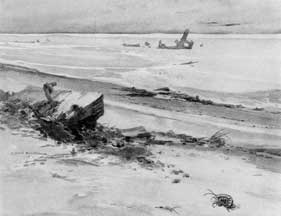Servants of the Sea
By BEN HUR LAMPMAN
Nature Magazine, March 1932
That vast and estimable dame we know as the ocean has a determined antipathy for all untidiness. So varied and prolific is the life she nurtures that death and dissolution are forever in her tides. Yonder a sea bird stricken far offshore, and there a great fish, monstrous and unreal, and everywhere the rubbish of her gardens, the streaming kelp, the lacy weed that is so like the flounce of a Victorian gown. Her shellfish perish in their seasons, and there are constantly recurrent fatalities among the crustaceans. The varicolored jellyfishes come to an end of days, and rent and torn by the tides are carried shoreward, while continually there is borne to the beach a great burden of minute marine forms, the algae, and indeed all plankton-that thin but nourishing soup-stock of the sea. In a single week of summer the beaches receive so much of outworn life that only for the wise provisions of Nature they would reek of death. But the sea, through her attendants, is intolerant of foulness and decay, and works interminably to keep her house in order.
It suffices to name but three of her principal servants, whose duty it is to police the beach, and to free the air from pollution, so that the sands are commonly as clean as a swept hearth, and the breeze untainted. These three are the hovering gulls, with an eye keen for any flotsam, the anchorite sea anemones, and those ubiquitous and agile crustaceans that are called sand fleas or sand hoppers. Of these three widely varying forms of life, these servants of the sea, possibly the most important service is that rendered by the omnivorous sand hopper, whose nimble antics appear so purposeless and frantic. For the anemone must bide where it is stationed, patient as time, and the gull is rather a finical fellow, exercising a somewhat narrow choice of foods, but the sand hopper is legion and everywhere, and its crustacean appetite asks no question of the fare that is spread. It gleans where the gull has feasted, it penetrates the mollusks that defy the bird, and its salad is kelp and weed.

To the sea anemone in its pool, whence current and tide cast both dead and living food, all that comes within reach of its tentacles is destined for its capacious stomach. In rose or emerald it blossoms as a flower, but its purpose is to satisfy hunger, and its loveliness screens avidity. Thus it combs the fringes of ocean for aught the tide may bring, and does important service toward the cleanliness of the sea. To the questing gull all meat is food, and since much of the sea's wastage is beyond the capacity of those other creatures that feed at the brink of the sea, and too huge of bulk for immediate demolition by the minor crustaceans, it follows that a deal of tidying is left to the midget sand hopper, The weed that drifts ashore this tide will be reduced to fibers. The shell will be purged of its content. The bones of the fish will be cleaned, and the crab's claw hollowed. It is true that the various creatures beneath and above the tides all serve to preserve the wholesomeness of mother ocean's beaches, yet at long and at last it is the sand hopper that best serves the purpose.
Appetite on the beaches knows no bounds. It is reported by one observer that a sea anemone, having swallowed a shellfish, was all but cleft by the distention. The position of the shell in the creature's stomach separated that organ in halves, the 'lesser of these being effectively blockaded from the mouth. Did the anemone pine and wither, and yield up its curious ghost because of this mishap? Not so. The instinctively resourceful creature proved a master of stratagem, and for that portion of the stomach which was blockaded it grew another mouth. And there it clung to its rock, gratifying not one hunger but two, and no doubt well pleased with itself. It had altered a misfortune to a benefaction, and in a general way it may be said that this is a secret men yet are seeking. Of the function of the sand hopper, in cleansing the beaches, an old work on the sea's creatures observes:
"The sand hoppers are extremely frequent on the shores of the arctic seas, where they emulate the tropical ants in their speedy removal of decaying substances. Thus Captain Holboll relates that, having enclosed a piece of shark's flesh in a basket, and let it down to a depth of 75 fathoms, in the Greenland sea, he by this means caught within two hours six quarts of these little creatures, while a vast number still followed the basket as it was hauled up."
So numberless are the sand hoppers, than which no living creature is more erratic, that we tread them down without thought, as casually as we tread upon the sand. Indeed, there is no choice. But should they vanish tomorrow, should the sea that spawned them briefly decree their extinction, our lack were sad enough. Far from the beaches, in the sweltering summer weather, we would talk of the golden days when there were lots-yes, lots-of sand hoppers, the gift of a wise and a truly tidy Nature.
 Printer-friendly version
Printer-friendly version
